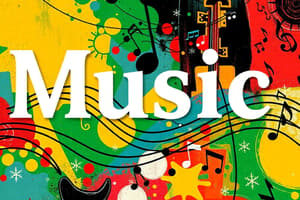Podcast
Questions and Answers
What is the definition of music?
What is the definition of music?
An art form whose medium is sound and silence.
Which of the following are aspects of rhythm? (Select all that apply)
Which of the following are aspects of rhythm? (Select all that apply)
- Pulse (correct)
- Melodic Rhythm (correct)
- Meter (correct)
- Dynamics
What is melody?
What is melody?
A series of tones sounding in succession.
What does dynamics refer to in music?
What does dynamics refer to in music?
Timbre is also known as ______.
Timbre is also known as ______.
What are the different kinds of texture in music? (Select all that apply)
What are the different kinds of texture in music? (Select all that apply)
What is the definition of tempo?
What is the definition of tempo?
Which of the following are types of musical forms? (Select all that apply)
Which of the following are types of musical forms? (Select all that apply)
Describe a strophic form.
Describe a strophic form.
Flashcards are hidden until you start studying
Study Notes
Definition of Music
- An art form utilizing sound and silence.
- Common elements include pitch, rhythm, dynamics, timbre, and texture.
- Derived from the Greek word μουσική (mousike), meaning "art of the Muses."
Rhythm
- Variation in sound accentuation over time.
- Organizes music temporally.
Aspects of Rhythm
- Pulse: A steady recurring beat.
- Melodic Rhythm: The rhythm pertaining to melody or lyrics.
- Meter: Beats arranged into recognizable patterns of accents.
Melody
- A sequence of tones presented in succession, organized by pitch.
- Represents the linear or horizontal aspect of pitch.
Elements of Melody
- Pitch: Reflects the perceived lowness or highness of sound, linked to wave frequency.
- Dynamics: Relates to the sound volume and execution styles, denoted in musical notation.
- Timbre: Also known as tone color; distinguishes different sound qualities produced by instruments or voices.
Harmony
- Involves the vertical interaction of pitches.
- Describes how melodies coexist and respond to one another.
Texture
- Refers to the number of musical lines and their interrelations.
- Monophony: Single melody without accompaniment.
- Homophony: Multiple notes simultaneously, often with chordal support.
- Polyphony: Multiple independent melodies occurring together.
Tempo
- Indicates the speed or pace of music, affecting mood and complexity.
- Beats per Minute (BPM): A unit measuring tempo.
- Measures per Minute (MPM): Counts the number of measures played in one minute.
Form
- The structural organization of a musical piece.
- Types of forms include:
- Binary: Two related sections, typically repeated (A-A-B-B).
- Ternary: Three-part structure with a return of the first section (A-B-A).
- Strophic: Same music for each stanza (AAAA...).
- Rondo: Alternating recurring theme and contrasting sections (ABACABA or ABACADAEA).
Studying That Suits You
Use AI to generate personalized quizzes and flashcards to suit your learning preferences.




